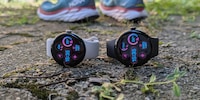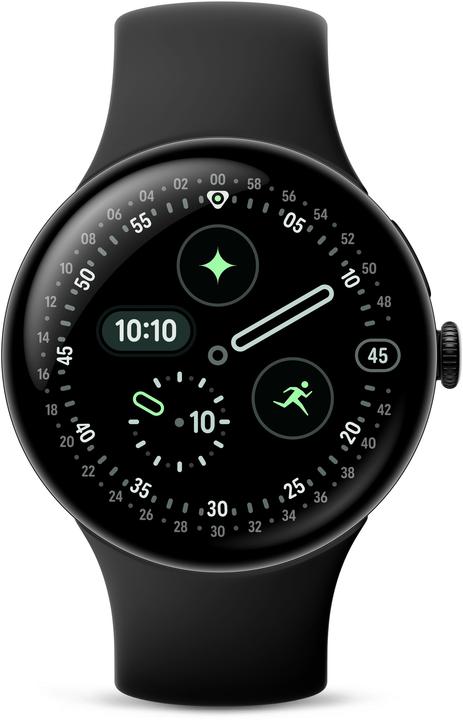

Pixel Watch 4 review: tougher, brighter and smarter
The fourth version of Google’s Pixel Watch has improved in practically all areas. Nevertheless, it won’t win over smartwatch critics.
Google already achieved great success with its last model. There, the focus was on a larger display and new running functions. In addition to numerous hardware upgrades, the Pixel Watch 4 now relies on – what else – AI. But even without artificial intelligence, the Pixel Watch 4 is impressive.
Brighter, bigger, and even more beautiful
The Pixel Watch 4 is once again available at 41 and 45 millimetres and optionally with 4G. I tested the fully equipped model. The LTPO display has the same pixel density (320 ppi) as its predecessor. LTPO screens let you benefit from a variable refresh rate between 1 and 60 Hz, improving battery life. At 3000 nits, it’s 50 per cent brighter. The display is also 10 per cent larger than the Pixel Watch 3 thanks to its thinner edge. I thought the last model was bright enough, but a bigger display area is always welcome.
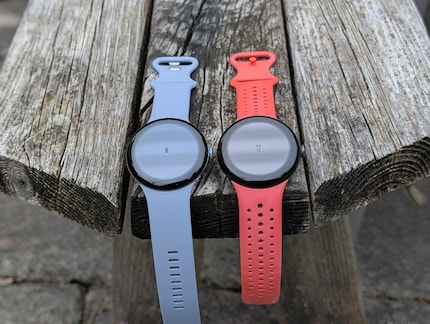
The display is now slightly curved towards the outside, which I initially found irritating. I almost got a little dizzy when scrolling through the app overview. Now, I think it’s pretty cool actually. It comes into its own particularly well on some dials.
The new Android design is also really snazzy. Google calls it Material 3 Expressive. It’s full of small, pretty animations. For example, new notifications briefly display full contact information. There’s also a rotating pause symbol when you play music, and the button you select slowly extends when closing messages. In general, the new design blends in wonderfully with the round shape of this watch.
Of course, there are new dials too. My current favourite is called «Reveal». It looks pretty simple at first glance. However, when you tap on it, the view changes and several interactive icons appear – all free to configure.
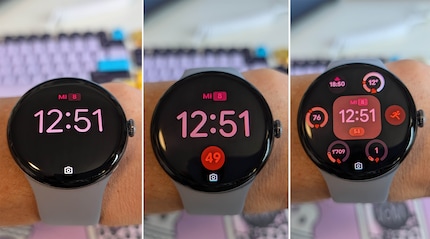
Better battery and new charging dock
One improvement that dedicated sports watch wearers might scoff at is the longer-lasting battery. It only offers around 5 per cent more mAh than before. With this, Google has calculated a battery life of 30 hours, or 40 hours for the larger model. The Pixel Watch 3 only managed 24 hours with an always-on display.
In my test, I even managed two and a half days with two one-hour training sessions, one of them using GPS. With power-saving mode, the official runtime grows two days for the 41 mm model and three for the large watch.
Speaking of charging, the Pixel Watch 4 comes with a new dock. Since the charging pins are now located on the side of the watch, it can be positioned much more easily. Until now, I always used a 3D printed bracket. Finally, I don’t have to use it any more.
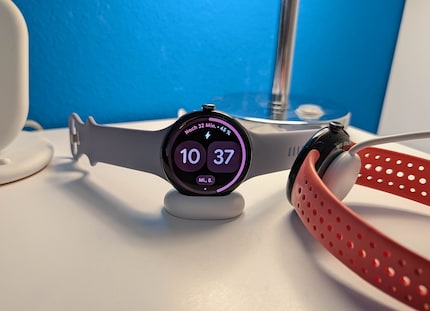
With its new dock, the watch charges 25 per cent faster, only needing 15 minutes to go from 0 to 50 per cent.
Proven controls and features
Nothing’s changed in how you control the watch. By swiping down from the top, you open the quick settings. Notifications appear from bottom to top. You scroll horizontally through tiles, giving you access to workouts, sleep data or appointments. Useful for anyone who needs this – sadly, that doesn’t include me. You can also launch all relevant apps directly from the watch face and via the button or rotating crown. This opens the app overview with one click, and the wallet with two.
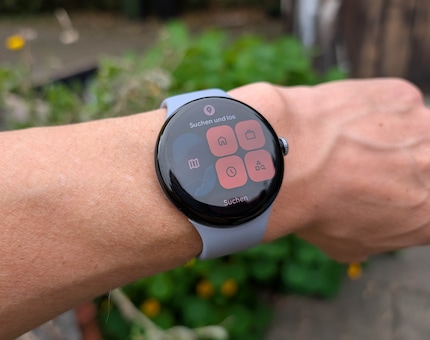
The button above it displays the last open apps. If you press and hold it, it’ll launch the Google Assistant or Gemini again. If you want, you can set it so that you only have to raise your arm to speak to the AI. This was always reliable. However, apart from setting reminders or making the phone ring when I couldn’t find it, I hardly used that feature. The Assistant already does both without any problems.
Navigation using both your finger and the crown is fast and precise. Google still uses a Qualcomm chip, their own Tensor CPUS apparently aren’t ready for smartwatches yet. The haptic feedback for various interactions and notifications is pleasantly complex.
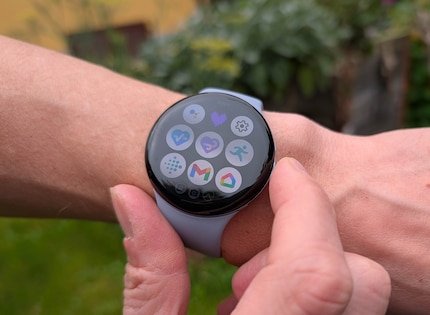
Thanks to the optimised speaker, Gemini sounds just a bit better. Again, the quality of the Pixel Watch 3 was more than sufficient to take a call on the device already.
To me, the digital camera viewfinder is still one of the most practical features. Using it, you can set up your smartphone and see its picture on the watch. Perfect for those two or three obligatory family selfies a year.
The watch is IP68 certified, with water resistance down to 5 ATM. Feel free to swim or shower with it, but remove it before going diving. The watch automatically detects when it’s wet and locks the display. This works while swimming, but drops and splashes still unintentionally trigger commands when showering. Still, it’s less frequent than on the Pixel Watch 3.
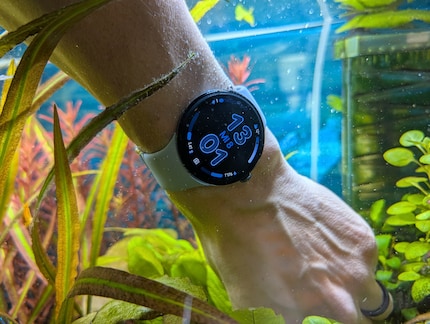
Otherwise, there are the usual features such as contactless payment, music via Bluetooth headphones, navigation and messaging. It’s a shame that Smart Replies are only available for Google’s own Messages app, not for Signal and the like. At least there’s a standalone app for WhatsApp which can read all messages and not just new ones.
For sound sleep
Fitbit’s renowned sleep tracking is another must-have. It apparently records sleep 18 per cent more accurately thanks to AI support. The results are very detailed, and there are suitable explanations for everything in the accompanying smartphone app. With Sleep Score, sleep duration and sleep phases, you can see at a glance how restful your night was. I still think it’s a gimmick. But just like with workouts, I always enjoy looking at personal statistics.
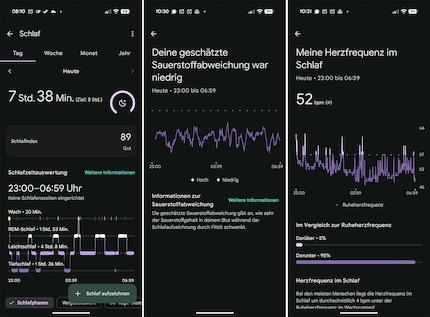
To track your sleep, all you have to do is keep the watch on. Sleep is automatically detected, and the watch switches to the right mode. As long as you always go to bed at roughly the same time, it’ll work wonderfully. When sleep mode is active, the display stays off and won’t glare in my wife’s face.
This was already the case on the Pixel Watch 3. It didn’t work precisely enough there, at least at launch, so I usually switched sleep mode on and off manually. Thankfully, this is finally a thing of the past with the Pixel Watch 4.
Some sleep data such as the monthly sleep profile or detailed sleep index are only included in the paid Fitbit Premium subscription. A six-month membership is included with the purchase of any Pixel Watch 4, after which it costs nine euros per month.
Work out with AI
Google’s watch can track 52 different sports, six of them automatically. After 15 minutes of cycling, cross-training, jogging, indoor cycling, rowing or walking, the Fitbit app will ask if you want to save the activity. You can choose if the start/end reminder pops up for each individual activity. That’s pretty great, since I don’t want to be bothered by a notification every time I ride my bike into town.
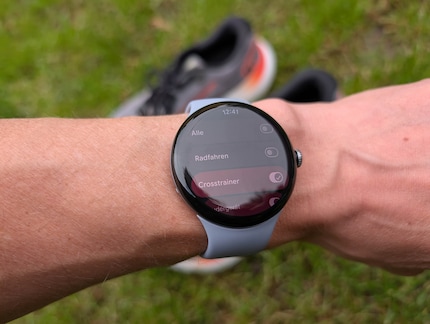
As a part of Fitbit Premium, you’ll receive AI-generated running workouts, all tailored to your daily fitness level. You can adapt these training sessions if necessary. What already bothered me last year was how the running programs aren’t easy to understand. For example, the title card of one run reads: 15 minutes. Looking at the detailed plan, it might last much longer including the warm-up, all the intervals and cooling down. I also still don’t immediately understand what exactly is part of an interval. As a result, those runs are always full of surprises for me.
Luckily, all content displayed during an activity is understandable and simple. You can see at a glance how long a segment lasts and what’s required. It’s easy to read, even when running.
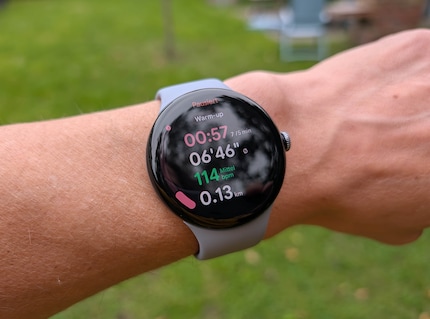
What bothers me is that you can turn off voice notifications, but not sounds. At least I couldn’t adjust this in any of the settings. The watch was constantly jingling when I reached the limit of my required heart rate. A simple buzz would’ve been more than enough.
Pulse hikes like on the Pixel Watch 3 are rarer. However, the fact that heart rate measurement is always around ten seconds late makes training related to it somewhat tedious. I often overshot my target long before the watch recognised any change in performance.
There’s nothing to complain about in terms of accuracy during route detection. The new dual-band GPS is even said to have improved detection compared to the Pixel Watch 3 thanks to two individual satellite frequencies. Still, that was enough for my amateur sporting requirements.
The Fitbit Premium package includes various workout videos for strength training, yoga, etc. The app suggests some tailored to you every day. You can also search the selection manually. The only thing that bothered me here was how badly training sessions in German were dubbed. You can only change language by changing the whole language of an app.
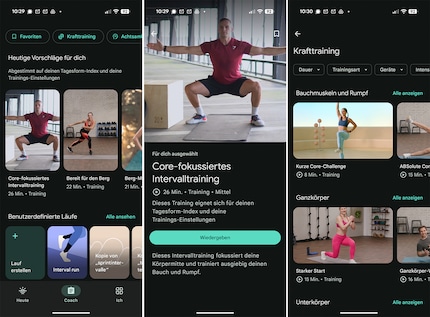
The Pixel Watch 4 also features ECG measurement, a skin temperature sensor, detects loss of heart rate and falls and can send emergency calls via satellite.
The Pixel Watch 4 will be available in two sizes from 9 October. I received the larger version with 4G from Google for testing.
In a nutshell
No rough edges, in both senses of the word
In last year’s review, I already mentioned how the new version made a good watch even better. This applies again to the Pixel Watch 4. It’s brighter, more durable, and the display is even bigger. The sensors measuring your sleep, workouts and the like are even more accurate. Your options for health recording and monitoring are becoming ever more extensive.
The design has also been refined, this watch is really fun to interact with. Remember, fun is a key factor. I still recommend the Pixel Watch more to amateur athletes like me over professionals. Its heart rate measurement is too inaccurate for them.
If you already own the Pixel Watch 3, there isn’t much reason to upgrade. Especially given those prices, almost 500 francs or euros depending on the model and size. But if you’re still using version two, you’ll definitely notice the numerous improvements.
Pro
- Battery lasts over two days
- Dazzlingly bright display
- Gemini on your wrist
- Pretty UI
Contra
- Heart rate measurement could be even faster
- Many features only available with Fitbit Premium subscription
- Expensive

As a child, I wasn't allowed to have any consoles. It was only with the arrival of the family's 486 PC that the magical world of gaming opened up to me. Today, I'm overcompensating accordingly. Only a lack of time and money prevents me from trying out every game there is and decorating my shelf with rare retro consoles.
